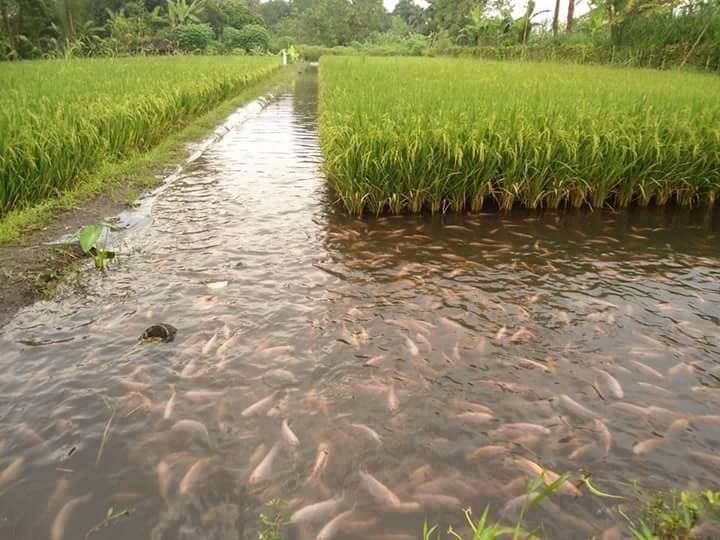
RICE-FISH CULTURE means growing of rice crop and fish together at the same time on the same piece of land. In rice-fish farming, farmers introduce another crop in the rice field and that crop is small fish. It also includes the growing of fish and rice one after another or growing simultaneously side by side in different compartments by using the same water. This technique seems to be good for both rice and fish. In this technique, fish lives in dense rice plants and in turn fish provide fertilizer in the form of their droppings, eat the insect pest and circulate the oxygen in a rice field. The researcher tells that by keeping the fish in a rice field, rice yield can be increased up to 10% and also additional supplies of fish.
Fish production in the rice field is as old as the practice of growing rice crop. Combined growing of fish and rice is also known as Paddy-cum-fish culture. The rice-fish culture was introduced in South-East-Asia about 1500 years ago from India, where now it is best developed. At the end of 19th century, rice-fish culture was practiced in Italy. Now it has spread to U.S.A. and is well established in other rice-growing countries like china, Japan, and Taiwan.
Preparation for Rice-Fish Culture
Rice field which is used for the fish culture has different water properties as compared to the ponds and lakes. In rice field usually the water depth is low. Because of this low depth, the temperature is also affected due to air temperature. During photosynthesis by the other vegetative plants, the oxygen in released in large amount. Thus, the dissolved oxygen of water is increased.
Usually, rice field with proper water supply, better drainage facility, abundant sunlight and high ability for water retention is suitable for fish culture. In the southern part of China, near the lakes and rivers there are deep water paddy fields in low areas. These low-lying fields are good bases for rice-fish cultivation.
Construction sheds and water structure
To maintain the proper water depth and to prevent escape of fish during the heavy rainfall, the bunds should be raised up to 33.3 to 50 cm. There should be hiding place for the fish during the shallow irrigation season, high temperature or during the application of fertilizers or insecticides. For this purpose, usually fish trenches or sumps are made after transplanting the nursery to facilitate the fish. Also, sheds are constructed on top of the sump to protect fish when the water temperature goes up to 39°C. In some places, there is no fish sumps and hole of 50-65 cm are made deeply on the side of the bund. This hole serves as an overwintering place in winter season and shed in summer. These holes are also better for fishes which prefer dim light.
Fish species
The most commonly used species of fish are tilapia, carps (common carp, crucian carp, European crucian carp, mirror carp), catfish, trout, snakehead argus etc. However, viviparous and macro brachium are also suitable for rice fields.
Stocking size
The fingerlings and fry which are stocked in rice fields should be healthy, without damaging scales and stout intact with their body surface. The optimum size of stocking for common carp is 10 cm or above and for silver carp and bighead is 20 cm or above. Catfish, mud carp, tilapia, and fingerlings are stocked after overwintering.
Management of Rice-Fish Culture
For rice-fish culture, knowledge of the rice farming and fish farming both are necessary. In addition to this, methods of draining, fillings, application of the insecticides and fertilizers is also must be understood.
Routine Rice Field Management
In rice-fish culture, it is necessary to see water structure for the proper amount of water and to control the escape of fish from structure. The optimum water depth of 16-17 cm should be maintained. While draining should be performed smoothly so that fish could reach the sumps or trenches. Also, attention should be given to the change in water temperature, as when the temperature increase up to 40°C then it is beyond the tolerance of common carp. In such cases, water should be changed with fresh water so that temperature is decreased.
Relationship of rice-fish culture and fertilization
It has stated that the development and growth of rice and fish are greatly affected due to quantity, kind and method of fertilizer application. Fertilizers like nitrogen, phosphorous and potassium which are required by rice crop are also nutrient material required by natural fish. Thus, the production of fish food is directly influenced due to the availability of the fertilizers.
Prevention of predators for rice-fish culture
There are many fish predators in the rice field, such as animals, birds, snakes, Cybister, Lactotrophs and frogs etc. The prevention from predators is very important in early stages as the rice is small and field is fully exposed. Instead of this, the swimming movement of fish also makes them susceptible to the predators. Again, during the harvesting period when the water is low in the field, fish exposed to predators. Thus, it is essential to control the loss by proper management of controlling predators. This predation can also be minimized by the increasing the water level in such way that growth of rice is not affected.